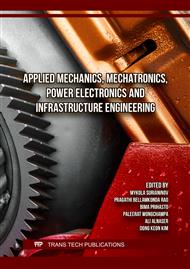[1]
M.Y. Arshad, A. Rashid, Integrating Circular Economy, SBTI, Digital LCA, and ESG Benchmarks for Sustainable Textile Dyeing: A Critical Review of Industrial Textile Practices, Global NEST Journal 25 (2023) 7.
DOI: 10.30955/gnj.005145
Google Scholar
[2]
F.R. Khandaker, B.B. Uddin, R. Mia, M.R. Islam, M.M. Hasan, Utilization of Post-Consumer Waste for Sustainable Denim Manufacturing, Case Studies in Chemical and Environmental Engineering 8 (2023) 100415.
DOI: 10.1016/j.cscee.2023.100415
Google Scholar
[3]
B. Stiehler-Mulder, T. Tselepis, Re-Tale: Proposing a Fifth Principle in the Sustainable Fashion Retail Story, The Thinker 95 (2023) 54-63.
DOI: 10.36615/the_thinker.v95i2.2523
Google Scholar
[4]
B. Sarı, F. Zarifi, M. Alhasan, H. Güney, S. Türkeş, S. Sırlıbaş, D.C. Yiğit, G. Kılınççeker, B. Şahin, O. Keskinkan, Determining the Contributions in a Denim Fabric Production for Sustainable Development Goals: Life Cycle Assessment and Material Input Approaches, Sustainability 15 (2023) 5315.
DOI: 10.3390/su15065315
Google Scholar
[5]
M.I. Islam, M.I. Patwary, S.B. Ali, et al., Comparative Analysis of Recycled Rotor Yarns Made from Cutting Table Waste with Large and Regular Percentages of Recycled Cotton, Cellulose 31 (2024) 677-684.
DOI: 10.1007/s10570-023-05654-2
Google Scholar
[6]
K. Yang, B. Lv, H. Shen, G. Jing, Z. Zhou, Coupling Life Cycle Assessment with Scenario Analysis for Sustainable Management of Disperse Blue 60, Environmental Science and Pollution Research International 27 (2020) 25197-25208.
DOI: 10.1007/s11356-020-08958-z
Google Scholar
[7]
T. Linhares, M.T.P. Amorim, LCA of Textile Dyeing with Acacia Dealbata Tree Bark: A Case Study Research, Procedia Engineering 200 (2017) 365-369.
DOI: 10.1016/j.proeng.2017.07.051
Google Scholar
[8]
M.A.R. Bhuiyan, A. Ali, M. Mohebbullah, et al., Recycling of Cotton Apparel Waste and Its Utilization as a Thermal Insulation Layer in High-Performance Clothing, Fashion and Textiles 10 (2023) 22.
DOI: 10.1186/s40691-023-00342-y
Google Scholar
[9]
M.M. Rahman, M.A. Reza, N. Rabea, D.R. Dola, F. Farin, Constructing and Evaluating the Features of Novelty Yarn Made from Denim Cut Waste, European Journal of Applied Sciences 11 (2023) 25-39.
DOI: 10.14738/aivp.111.13738
Google Scholar
[10]
A.P. Manian, S. Müller, D.E. Braun, T. Pham, T. Bechtold, Dope Dyeing of Regenerated Cellulose Fibres with Leucoindigo as Base for Circularity of Denim, Polymers 14 (2022) 5280.
DOI: 10.3390/polym14235280
Google Scholar
[11]
L. Peng, Y. Chen, Z. Wan, et al., Chemical Recycling of Waste Cellulose Denim Fabric and Re-Dyeing Process, Cellulose 31 (2024) 8387-8401.
DOI: 10.1007/s10570-024-05951-4
Google Scholar
[12]
F.Ş. Fidan, E.K. Aydoğan, N. Uzal, Sustainability Assessment of Denim Fabric Made of PET Fiber and Recycled Fiber from Postconsumer PET Bottles Using LCA and LCC Approach with the EDAS Method, Integrated Environmental Assessment and Management 20 (2024) 2347-2365.
DOI: 10.1002/ieam.4979
Google Scholar
[13]
D. Sofronova, Towards Sustainable Jeans Production: Experimental Evaluation of a Denim Fabric to Abrasion Resistance by Dry Fabric-to-Fabric Rubbing, IOP Conference Series: Earth and Environmental Science 1380 (2024) 012027.
DOI: 10.1088/1755-1315/1380/1/012027
Google Scholar
[14]
A. Basak, S.C. Paul, W. Rahman, A Comparative Study on Physical and Mechanical Properties of 100% Cotton Denim and Blended Cotton Denim after Industrial Washing, International Journal of Science and Research Archive 10 (2023) 194-212.
DOI: 10.30574/ijsra.2023.10.1.0709
Google Scholar
[15]
S. Muthu, Textiles and Clothing Sustainability: Recycled and Upcycled Textiles and Fashion, Springer, 2017.
Google Scholar
[16]
F.Ş. Fidan, E.K. Aydoğan, N. Uzal, An Integrated Life Cycle Assessment Approach for Denim Fabric Production Using Recycled Cotton Fibers and Combined Heat and Power Plant, Journal of Cleaner Production 287 (2021) 125439.
DOI: 10.1016/j.jclepro.2020.125439
Google Scholar
[17]
M. Kanan, B. Wannassi, A.S. Barham, M. Ben Hassen, R. Assaf, The Quality of Blended Cotton and Denim Waste Fibres: The Effect of Blend Ratio and Waste Category, Fibers 10 (2022) 76.
DOI: 10.3390/fib10090076
Google Scholar
[18]
G. Sandin, G.M. Peters, Environmental Impact of Textile Reuse and Recycling: A Review, Journal of Cleaner Production 184 (2018) 353-365.
DOI: 10.1016/j.jclepro.2018.02.266
Google Scholar
[19]
C. Rajeshkumar, T. Vidya, J. Kanimozhi, D. Raja, J. Balaji, M. Jayakumari, C. Prakash, Study on Fibre Reinforced Composites Developed by Using Recycled Fibres from Garment Cut Waste, International Journal of Clothing Science and Technology 34 (2022) 605-614.
DOI: 10.1108/ijcst-02-2022-0029
Google Scholar
[20]
M. Ahirwar, B.K. Behera, Appraisal of Hand Value of Denim Fabrics, Research Journal of Textile and Apparel, ahead-of-print (2023).
DOI: 10.1108/rjta-11-2022-0136
Google Scholar
[21]
S. Wang, J. Egan, S. Salmon, Preparation and Characterization of Cotton Fiber Fragments from Model Textile Waste via Mechanical Milling and Enzyme Degradation, Cellulose 30 (2023) 10879-10904.
DOI: 10.1007/s10570-023-05527-8
Google Scholar
[22]
R.J. Hron, D.J. Hinchliffe, G.N. Thyssen, et al., Interrelationships between Cotton Fiber Quality Traits and Fluid Handling and Moisture Management Properties of Nonwoven Textiles, Textile Research Journal 93 (2023) 4197-4218.
DOI: 10.1177/00405175221132011
Google Scholar
[23]
M. Lewin (Ed.), Handbook of Fiber Chemistry, third ed., CRC Press, New York, 2006.
Google Scholar
[24]
H. Memon, H.S. Ayele, H.M. Yesuf, L. Sun, Investigation of the Physical Properties of Yarn Produced from Textile Waste by Optimizing Their Proportions, Sustainability 14 (2022) 9453.
DOI: 10.3390/su14159453
Google Scholar
[25]
B.G. Turkmen, P. Celik, H. Sehit, T.B. Ute, Investigation of the Effects of Hollow Yarn Structure and Woven Fabric Construction on Fabric Performance: Mechanical Properties, The Journal of The Textile Institute 115 (2023) 490-503.
DOI: 10.1080/00405000.2023.2196044
Google Scholar
[26]
N. Egels-Zandén, N. Hansson, Supply Chain Transparency as a Consumer or Corporate Tool: The Case of Nudie Jeans Co, Journal of Consumer Policy 39 (2016) 377-395.
DOI: 10.1007/s10603-015-9283-7
Google Scholar
[27]
M.M. Motin, H.M. Haq, A.N. Khan, O.M. Rahman, M.O. Ali, Investigating the Ideal Combination of Virgin Cotton Fibre Length with Recycled Fibre for Better Yarn Quality, Textile & Leather Review 7 (2024) 391-402.
DOI: 10.31881/tlr.2024.009
Google Scholar
[28]
E.H. Nizam, S. Uddin, M. Moniruzzaman, A.R.S. Sarker, Effect of Different Crushed Stone on Denim & Knit Fabric to Ensure Sustainability, American Journal of Science, Engineering and Technology 8 (2023) 97-103.
DOI: 10.11648/j.ajset.20230802.13
Google Scholar
[29]
S.U. Akı, C. Candan, B. Nergis, N.S. Önder, Life-Cycle Assessment as a Next Level of Transparency in Denim Manufacturing, IntechOpen (2023).
DOI: 10.5772/intechopen.110763
Google Scholar
[30]
S.U. Akı, C. Candan, B. Nergis, N.S. Önder, Understanding Denim Recycling: A Quantitative Study with Lifecycle Assessment Methodology, Waste in Textile and Leather Sectors (2020).
DOI: 10.5772/intechopen.92793
Google Scholar


